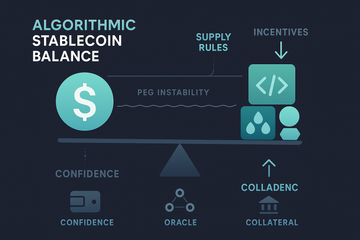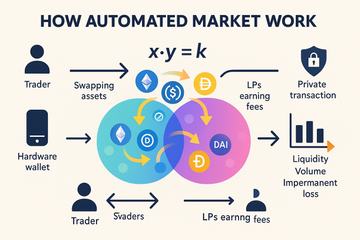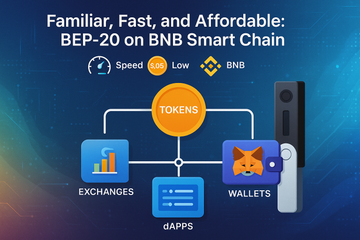The application layer sits where people actually touch a blockchain. It is the front door, the screen, the buttons, the clear signposts that help users send value and read data. If the protocol layer is the engine, the application layer is the dashboard and the steering wheel. Simple, visible, and frankly, the part folks remember.
Let me explain what that means in practice. Apps, wallets, and web front ends wrap smart contracts with everyday language. They bundle permissions, set sane defaults, and hide gnarly details like gas math or nonce handling. When you click Swap on a page like Uniswap, the application layer translates that wish into a signed transaction, sends it through a node, then renders the result as fast as your connection allows.
You know what? That translation job is harder than it looks. Networks have quirks. Fees fluctuate. Tokens misbehave. Good app layers shield newcomers without confusing power users. That balance takes care, and it separates sticky products from forgettable ones.
What is in the application layer, really?
At a high level, you will usually find four parts working together.
- Wallets, both software and hardware.
- Web or mobile front ends.
- Middleware, like RPC providers and indexing.
- SDKs and standards that keep the parts in sync.
Wallets act like browsers for money. MetaMask, Phantom, and Rabby give you keys, address books, and simple signing views. Mobile apps add push confirmations and biometrics. On the desktop, browser extensions keep flows snappy. For cold storage, hardware options lock secrets inside a secure chip. Ledger Live and Trezor Suite bridge that safety with the convenience of a friendly app.
Middleware ties it all together. You might see providers like Alchemy, Ankr, or Infura. They serve RPC, websockets, and sometimes batched mempool reads. Indexers like The Graph or Goldsky cache on chain history, so pages can show positions or collectibles without heavy queries. It feels like magic, but it is simply good plumbing.
The wallet, your quiet co pilot
A wallet holds keys, but it also holds context. It remembers your networks, tracks past transactions, and filters spam. Good wallets help you understand what you are signing. Better wallets explain risk in plain words. The goal is to make the scary parts less scary, without hiding the truth.
Hardware wallets add a second line of defense. The chip signs only after you approve details on a tiny screen. If a malware filled laptop tries to change the recipient, the hardware screen reveals the trick. That simple pause breaks many attacks. It is slower, yes, yet the calm is worth it when real money is on the line.
Ledger and Trezor both push steady improvements. Ledger Live supports staking, swaps, and NFT views across major chains. Trezor Suite focuses on clarity, letting you send, label, and verify with little fuss. Many web apps connect through WalletConnect or a USB bridge, so you keep cold keys while still clicking around like normal.
Front ends that feel like normal apps
Contract ABIs do not explain feelings. People do. Good front ends give human names to scary functions. Approve becomes Give permission. Burn becomes Withdraw and close. When that naming lines up with clear buttons, folks move with confidence.
Standards, SDKs, and the glue you do not see
Standards keep the chaos tidy. EIP 4361, Sign In With Ethereum, lets sites request a human friendly signature that proves control of an address. WalletConnect links phones to laptops without raw private keys ever leaving the device. Libraries like ethers and Viem make reads and writes feel like simple function calls.
On Solana, the wallet adapter pattern keeps Phantom, Solflare, and hardware bridges aligned. On Bitcoin, PSBT flows help devices share signing steps safely. Each chain grows its own toolkit, yet the intent stays the same, make safe actions feel normal.
Account abstraction, less friction, more sanity
There is a reason everyone talks about account abstraction. Externally owned accounts are simple, but they shove gas and nonces in your face. Smart accounts shift that pain into code. With ERC 4337, apps can sponsor gas, batch actions, and create session keys that expire. That means fewer pop ups and fewer broken flows.
Social recovery, passkeys, and spending limits fit the same story. People forget things. Phones get lost. A wallet that can recover with trusted contacts, or with a hardware backup, keeps users in the game. The trick is clear rules and clear language, so help never feels like a trap.
Security feels like UX, because it is
Security and comfort are not opposites. They grow together. Phishing checks, human readable contract names, and real time allowlists reduce fear without nagging. If your app shows risks early, users learn without being burned.
Where hardware wallets fit in the app layer
Some folks think hardware lives on the edge. I think it sits right in the heart of the experience. Ledger and Trezor do two jobs, they keep the private key sealed, and they give you a second display that cannot be spoofed by your browser. A front end that shows the same amount and the same address that you see on the device earns trust in a way no banner can.
This is why well made flows pair software prompts with device checks. Show formatted ENS names, then show raw hex on the device for final review. Add QR signing for air gapped machines. Use WalletConnect with hardware support, so mobile users can sign safely while browsing on a laptop.
Practical tips for builders and curious users
Small habits, big safety
If you trade or collect, set a simple routine. Confirm URLs, lock your seed in a fire safe, and check device firmware every quarter. Keep a small hot wallet for play money, then keep the stash on a hardware device. Habits save coins.
What success looks like, beyond charts
Numbers help, but feelings tell the rest. Watch repeat visits, fewer failed transactions, and faster time to first success. If support drops after a copy tweak, keep that change. If passkeys or hardware cuts fraud, double down. Evidence lives in calmer users, not only dashboards.
Where this is going next
Two trends stand out. More intent based flows will shape requests behind the scenes, then present a single clear approval. And keys will feel lighter. Expect passkeys, social recovery, and deeper hooks with Ledger and Trezor when amounts spike. Big moves stay cold, small ones stay quick.
If one idea sticks, let it be this. The application layer turns code into comfort. Speak clearly. Pair great screens with hardware. Respect risk, respect time, and people will come back often.











